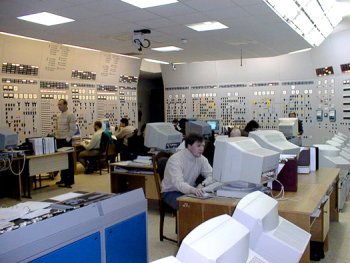![]()
Improving the Safety of Day-to-Day Operations
Simulators Strengthen Skills of Control-Room Operators
|
US Dept. of Energy Office of International Nuclear Safety and Cooperation 1000 Independence Ave S.W. Washington, DC 20585 (202) 586-6641 https://insp.pnnl.gov:2080/ |
A nuclear power plant simulator is an effective, efficient training tool used widely in the international nuclear industry. Its computer programs simulate a variety of plant conditions, giving control room operators practice in responding to routine and emergency situations. Two types of simulators are used in control-room training. A full-scope simulator provides hands-on training by replicating the control room of a nuclear power plant. A computer links an instructor station with a full-size physical replica of the control panels. The instructor can select the initial conditions, introduce malfunctions and failures, freeze the exercise, and enable retrospective viewing.
In contrast, an analytical simulator uses computer monitor screens instead of replicated control panels. The computer's graphic displays represent plant systems. Operators practice responding to various conditions by entering computer commands. U.S., Ukrainian, and Russian organizations are working together to develop control room simulators for Soviet-designed nuclear power plants. Each simulator, whether full-scope or analytical, must be designed to replicate the exact configuration and behavior of each particular reactor. The first full-scope training simulator developed with U.S. support for a Soviet-designed nuclear power plant began operating in December 1997 at Ukraine's Khmelnytskyy plant. U.S. contractor GSE Power Systems, Inc., developed this simulator with support from LAKROM, a Russian subcontractor. GSE, with support from LAKROM, also produced an analytical simulator for the Unit 3 reactor at Ukraine's Chornobyl plant. The simulator came on-line in February 1998. GSE is working with the Russian Institute of Nuclear Power Plant Operations (VNIIAES) to produce full-scope simulators for Russia's Kola Unit 4 and Kalinin Unit 2. GSE has provided the computer hardware and software, and VNIIAES is providing the system models. These projects are scheduled for completion in 1999. GSE has developed an analytical simulator for Novovoronezh Unit 3, with support from LAKROM. The simulator passed factory acceptance tests in July 1998. GSE also is developing analytical simulators for Russia's Balakovo and Bilibino plants, which are scheduled for installation in 1999. To upgrade an existing full-scope simulator at Balakovo, GSE will update system models developed for the plant's analytical simulator and provide new hardware and software. In 1996, the Engineering and Technical Center for the training of nuclear industry personnel was established to develop and maintain control room simulators for plants throughout Ukraine. Staff from the Khmelnytskyy plant and Energoatom (utility responsible for Ukraine's nuclear power plants) received on-the-job training in simulator technology from March 1995 to March 1996. Ukraine built on this expertise to establish the center, and the United States provided computer hardware and software. GSE, LAKROM, and the center are collaborating on the development of a full-scope simulator for South Ukraine Unit 3, and hardware and software to upgrade an existing full-scope simulator at Zaporizhzhya Unit 5. Both projects will be completed in 1999. Other simulator projects in Ukraine include full-scope simulators for the UnitĘ 3 reactor at the Rivne plant and the Unit 1 reactor at the South Ukraine plant. Completion of these projects is scheduled for 2001. The United States also is supporting upgrades for a full-scope simulator at Slovakia's Trnava Training Center, to be completed in 1999. The center is located in the city of Trnava. Staff provide training throughout the region to nuclear industry personnel working at Soviet-designed reactors. In a related project, U.S. and host-country specialists are developing safety parameter display systems for Soviet-designed plants. The display systems give control-room operators crucial information about plant conditions. To improve operator training, simulated safety parameter display systems will be integrated into full-scope simulators for VVER-1000 reactors in Ukraine. The simulators for Zaporizhzhya Unit 5 and Khmelnytskyy Unit 1 will receive this upgrade early in 1999. As control room simulators for other Ukrainian VVER-1000 reactors are designed and completed, simulated safety parameter display systems will be included. |
